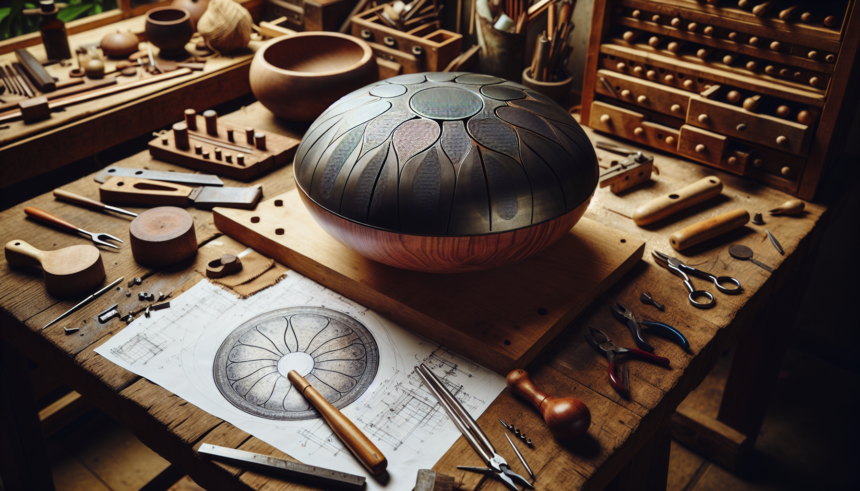Handpans, with their ethereal sounds and mesmerizing aesthetics, have captivated musicians and listeners alike. One brand that stands out in the realm of handpan creation is Yishama. Known for their unparalleled craftsmanship and unique tonal quality, Yishama handpans are the epitome of handmade perfection. This article delves into the intricate process of creating a Yishama handpan, showcasing the dedication and expertise that goes into each instrument.
Step 1: Material Selection
The journey of a Yishama handpan begins with the careful selection of materials. High-quality steel is paramount, as it directly influences the resonance and durability of the instrument. Yishama uses nitrided steel, known for its corrosion resistance and robust acoustic properties. This type of steel undergoes a specialized heat treatment process, enhancing its hardness and ensuring a stable, consistent tone.
Step 2: Shaping the Shells
Once the steel is procured, the next stage involves shaping the shells. Two steel sheets are meticulously hammered into their iconic convex shape. This is an essential step, as the dome structure plays a crucial role in sound production and quality. The artisans at Yishama use a combination of manual hammering and high-precision techniques to achieve the perfect curvature, a process that demands both physical endurance and an acute eye for detail.
Step 3: Tuning the Notes
After the shells are shaped, the tuning process begins. This is the heart of handpan creation, where the magic happens. Each handpan is crafted with a central note – called the Ding – and an array of surrounding notes. Yishama handpans are renowned for their unique scales and harmonic richness. The tuning process is painstakingly detailed, involving numerous hours of hammer work to ensure each note is perfectly pitched and harmonically synchronized with the others. This stage is repeated several times to accommodate the complex interaction between the notes and the steel.
Step 4: Helmholtz Resonators
A distinctive feature of Yishama handpans is the integration of Helmholtz resonators. These small, precisely drilled holes and cavities adjust the air resonance within the handpan, contributing to the depth and sustain of the sound. The placement and size of these resonators are calculated with scientific precision, allowing the handpan to produce a rich, complex tone that is both soothing and dynamic.
Step 5: Final Assembly
The final assembly of a Yishama handpan involves joining the two shells and sealing them with meticulous attention to detail. This step requires a seamless fit to maintain the structural integrity of the instrument while ensuring its acoustic properties remain uncompromised. Special adhesives and techniques are employed to ensure a lasting bond that can withstand the vibrations and impacts of regular play.
Step 6: Double Checking the Tuning
Post assembly, the tuning is rechecked and refined. This iterative process ensures that any slight alterations caused by the assembly are corrected. Master tuners at Yishama carefully adjust and fine-tune each note, achieving the perfect pitch and harmonic structure that Yishama handpans are known for. This meticulous attention to tuning guarantees that each handpan meets the highest standards of musical excellence.
Step 7: Finishing Touches
The final stage involves adding the finishing touches to the handpan. This includes polishing the surface to a gleaming finish and applying protective coatings that enhance durability and aesthetic appeal. Yishama handpans often feature unique engravings and designs that add to their artisanal charm. Each instrument is a work of art, visually stunning and sonically exceptional.
Step 8: Quality Control
Before a Yishama handpan is deemed ready for shipment, it undergoes rigorous quality control checks. The instruments are tested for sound quality, structural integrity, and aesthetic perfection. Any anomalies are addressed, ensuring that only the finest handpans leave the workshop.
Conclusion
The creation of a Yishama handpan is a labor of love, combining traditional craftsmanship with scientific precision. Each instrument is a testament to the dedication and skill of the artisans who create them. The process is intricate and demanding, yet the result is a handpan of unparalleled quality and beauty. For musicians and enthusiasts, Yishama handpans offer a unique musical experience, blending harmonious sounds with stunning artistry. The journey from raw steel to a finished handpan is a fascinating tale of passion, expertise, and an unwavering commitment to excellence.
FAQs
1. What makes Yishama handpans unique?
Yishama handpans are renowned for their meticulous craftsmanship, superior material quality, and unique soundscapes. The integration of Helmholtz resonators and the precise tuning process contribute to their rich, harmonious tones.
2. How long does it take to create a Yishama handpan?
The creation of a Yishama handpan can take several weeks, depending on the complexity of the tuning and the customization requirements. Every stage of the process is carefully managed to ensure the highest quality.
3. Can I customize the scale of my Yishama handpan?
Yes, Yishama offers customization options for the scale of your handpan. You can work with the tuners to select specific notes and scales that suit your musical preferences.
4. How should I care for my Yishama handpan?
To maintain your Yishama handpan, regularly clean the surface with a soft, dry cloth and avoid exposure to extreme temperatures or moisture. Applying a protective oil periodically can help preserve its finish and tuning.
5. Where can I purchase a Yishama handpan?
Yishama handpans can be purchased directly from their official website or from select authorized dealers. Due to their handcrafted nature, there may be waiting periods for custom orders.





